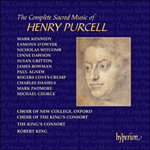Probably written during 1678, this ten-part full anthem is an astonishing work and would show extraordinary mastery of large-scale vocal textures by any composer, let alone one still in his teens. The text, from the book of Joel, is traditionally a Lenten one, but Purcell’s opening is anything but penitent, with ringing trumpet fanfares thrown between the seven solo voices. At ‘sanctify a fast’ the key changes from C major to three flats, and Purcell’s rich harmonic language is immediately to the fore: a ‘solemn assembly’ is called, and there is a marvellous build-up through the vocal entries of ‘and sanctify the congregation’. The chorus interrupt briefly, restating the joyful opening music and ending on a marvellous ten-part chord of C major which must have rung spectacularly through the Chapel Royal. Next Purcell contrasts groups of lower and upper voices, the lower voices portraying the elders and the bridegroom, the upper voices children and the bride.
There is daring augmented harmony at ‘let them weep’, but even this pales into insignificance when set alongside the imploring ‘Spare thy people, O Lord’: the harmonic shift from ‘people’ to ‘O’ is one of the most devastating moments in all Purcell’s church music. Once again the chorus make a brief entrance, repeating the rich material from the preceding section, and then the soloists enter with an imitative ‘Wherefore should they say amongst the people’: the point is stated some twenty times before block chords demand ‘Where is their God?’. The chorus repeats the same section, their added numbers lending weight both to the question and to Purcell’s marvellous inner vocal parts.
from notes by Robert King ©
L'antienne complète à dix parties, Blow up the trumpet in Sion, est une oeuvre étonnante, probablement écrite dans le courant de l'année 1678, qui révèle une maîtrise de textures vocales à grande échelle extraordinaire de la part de tout compositeur, sans parler d'un musicien qui n'avait pas encore atteint la vingtaine. Le texte tiré du Livre de Joël, est un texte de carême traditionnel mais l'ouverture de Purcell est tout sauf repentante, avec des fanfares de trompettes résonnantes intercalées entre les sept voix solistes. A 'Sanctify a fast' (Sanctifie un jeûne), la tonalité passe de Tut majeur à trois bémols et le riche langage harmonique de Purcell occupe immédiatement l'avant-scène: une "solemn assembly" (assemblée solennelle) est convoquée et nous avons un développement merveilleux avec les entrées des voix de 'and sanctify the congregation' (et sanctifie la congrégation). Le choeur fait une brève interruption en reprenant la joyeuse musique d'ouverture et se termine sur un merveilleux accord d'ut majeur à dix parties dont le retentissement dans la Chapelle Royale a dû être spectaculaire. Ensuite Purcell fait contraster des groupes de voix basses et hautes, le ténor et les voix de basse représentant les anciens et le jeune marié, les voix hautes jouant le rôle des enfants et de la mariée. Il y a une harmonie augmentée audacieuse à 'let them weep' (laisse-les pleurer), mais elle aussi pâlit et devient insignifiante lorsque placée à côté de l'implorant 'Spare thy people, O Lord' (Epargne ton peuple, O Seigneur): le décalage harmonique entre 'people' et 'O' est l'un des moments les plus accablants de toute la musique sacrée de Purcell. Le choeur fait de nouveau une courte apparition, en répétant la matière riche de la section précédente puis les solistes interviennent dans une section imitative ' Wherefore should they say amongst the heathen' (Pourquoi dirait-on parmi les peuples), le point étant énoncé près de vingt fois parmi les voix avant que des accords plaqués ne demandent ' Where is their God?' (Où est leur Dieu?). Le choeur répète la même section, cette addition donnant du poids à la question et aux merveilleuses parties vocales médianes de Purcell.
extrait des notes rédigées par Robert King © 1992
Français: Martine Erussard
Das zehnteilige 'Full Anthem' Blow up the trumpet in Sion wurde wahrscheinlich im Jahre 1678 geschrieben. Es ist ein erstaunliches Werk, da es die außergewöhnlich gute Handhabung großer Stimmstrukturen nicht nur eines Komponisten allgemein aufzeigt, sondern auch die eines Komponisten, der noch nicht einmal sein zwanzigstes Lebensjahr erreicht hat. Der Text aus dem Buch Joel ist traditionell mit der Fastenzeit verbunden. Jedoch ist Purcells Einleitung mit ihren klaren Fanfarenstößen unter den sieben Solostimmen alles andere als ein Aufruf zur Buße. Bei 'Sanctify a fast' (Verordnet ein heiliges Fasten) wechselt die C-Dur-Tonart auf drei Kreuzchen über, und Purcells reichhaltige Harmoniesprache macht sich gleich bemerkbar: es wird eine 'solemn assembly' (Versammlung) berufen, und mit ihren Einsätzen bauen sich die einzelnen Stimmen zu einem wunderbaren 'and sanctify the congregation' (und segne sie Versammlung) auf. Der Chor wird kurz unterbrochen, die freudige Einleitung wiederholt und die Anthem endet mit einem großartigen zehnteiligen C-Dur-Akkord, der in der Chapel Royal wohl ungemein imposant geklungen haben muß. Anschließend stellt Purcell die unteren und oberen Stimmgruppen einander gegenüber, wobei die Tenöre und Bässe die Ältesten und den Bräutigam und die Oberstimmen die Kinder und die Braut darstellen. In 'let them weep' (sie sollen weinen) erklingt eine gewagt augmentierte Harmonie, die selbst jedoch unscheinbar wird, wenn sie dem flehenden 'Spare thy people, O Lord'(Schone, Jahwe, deines Volkes) gegenübergestellt wird: die harmonische Verschiebung von 'people' auf 'O' bildet einen der überwältigendsten Augenblicke in der gesamten Kirchenmusik Purcells. Und wieder erklingt ein kurzer Einsatz des Chors, eine Wiederholung des reichhaltigen Stoffes aus dem vorhergehenden Teil. Dann beginnen die Solisten einen imitativen Abschnitt mit 'Wherefore should they say amongst the heathen' (Warum soll man unter den Heiden sagen), in dem die einzelnen Stimmen diese Frage zwanzigmal stellen, bevor mit Akkordgruppen gefragt wird ' Where is their God?' (Wo ist ihr Gott?). Der Chor wiederholt denselben Abschnitt noch einmal, wobei die größere Stimmenzahl sowohl der Frage als auch Purcells wunderbarer Behandlung der Solostimmen Gewicht verleiht.
aus dem Begleittext von Robert King © 1992
Deutsch: Meckie Hellary


 Purcell: The Complete Sacred Music
Purcell: The Complete Sacred Music
